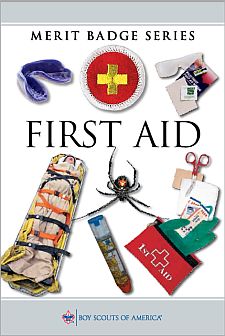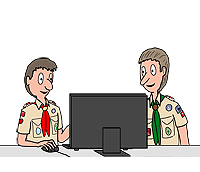This Merit Badge
is Required to earn the Eagle Scout Rank
- Demonstrate to your counselor that you have current knowledge of all first-aid requirements for Tenderfoot, Second Class, and First Class ranks.
- Explain how you would obtain emergency medical assistance from:
- Your home
- A remote location on a wilderness camping trip
- Define the term triage. Explain the steps necessary to assess and handle a medical emergency until help arrives.
- Explain the precautions you must take to reduce the risk of transmitting an infection between you and the victim while administering first aid.
- Do the following:
- Prepare a first-aid kit for your home. Display and discuss its contents with your counselor.
- With an adult leader, inspect your troop's first-aid kit. Evaluate it for completeness. Report your findings to your counselor and Scout leader.
- Describe the early signs and symptoms of each of the following and explain
what actions you should take:
- Shock
- Heart attack
- Stroke
- Do the following:
- Describe the conditions that must exist before performing CPR on a person.
- Demonstrate proper CPR technique using a training device approved by your counselor.
- Explain the use of an automated external defibrillator (AED).
- Demonstrate or simulate the proper use of an automated external defibrillator (AED), using an AED training device if available.
- Identify the location of the AED at your school, place of worship, and troop meeting place, if one is present.
- Do the following:
- Show the steps that need to be taken for someone who has a large open wound or cut that is not bleeding severely.
- Show the steps that need to be taken for someone who has a large open wound or cut that is severely bleeding.
- Explain when it is appropriate and not appropriate to use a tourniquet. List some of the benefits and dangers of the use of a tourniquet.
- Demonstrate the application of a tourniquet without tightening it.
- Explain when a bee sting could be life threatening and what action should be taken for prevention and for first aid.
- Describe the signs, symptoms, and potential complications of a fracture and dislocation.
- Demonstrate the proper procedures for handling and immobilizing suspected
closed and open fractures or dislocations of the
- Fingers
- Forearm
- Wrist
- Upper leg
- Lower leg
- Ankle
- Describe the signs, symptoms, and possible complications and demonstrate care for someone with a suspected injury to the neck or back.
- Describe symptoms, proper first-aid procedures, and possible prevention
measures for the following conditions:
- Concussion
- Anaphylaxis/allergic reactions
- Asthma attack
- Bruises
- Sprains or strains
- Hypothermia
- Frostbite
- Burns—first, second, and third degree
- Convulsions/seizures
- Dehydration
- Muscle cramps
- Heat exhaustion
- Heat stroke
- Abdominal pain
- Broken, chipped, or loosened tooth
- Do the following:
- Describe the conditions under which an injured person should be moved.
- If a sick or an injured person must be moved, tell how you would determine the best method. Demonstrate this method.
- With helpers under your supervision, improvise a stretcher and move a presumably unconscious person.
- Describe the following:
- The indications that someone might be a danger to themselves or others.
- What action you should take if you suspect that someone might be a danger to themselves or others.
- Teach another Scout a first-aid skill selected by your counselor.
BSA Advancement ID#:
8
Scoutbook ID#:
51
Requirements last updated in:
2024
Pamphlet Publication Number:
35897
Pamphlet Stock (SKU) Number:
Pamphlet Revision Date:
|
|||||||
Page updated on: February 05, 2024









